What are the hidden keys to wealth within Arbitrum's RWA ecosystem?
Reposting original article: "350 Million Is Just the Beginning: What Wealth Secrets Are Hidden in Arbitrum’s RWA Ecosystem?"
Summary
For many, access to Real World Assets (RWA) has become a key indicator of whether cryptocurrency has truly entered the mainstream. Only when we connect the on-chain environment with traditional finance can crypto gain status as a truly attractive mainstream asset.
The vision is turning into reality: U.S. Treasuries, bonds, and even real estate have been tokenized and moved on-chain.
With both regulatory clarity and maturing technology driving the sector, RWAs are gaining considerable momentum.
This article examines the Arbitrum ecosystem—a Layer 2 solution that has successfully launched multiple RWA-focused projects, now boasting over $350 million in RWA total value locked (TVL).
We provide an overview of RWA on Arbitrum, highlight the projects and initiatives behind its growth, profile major assets and providers (with case studies), and assess risk factors and future outlook.
Overview of RWA on Arbitrum
The RWA market is booming. Early crypto adopters once imagined Wall Street using crypto; today, that scenario is playing out as real world assets are successfully brought on-chain and widely adopted.
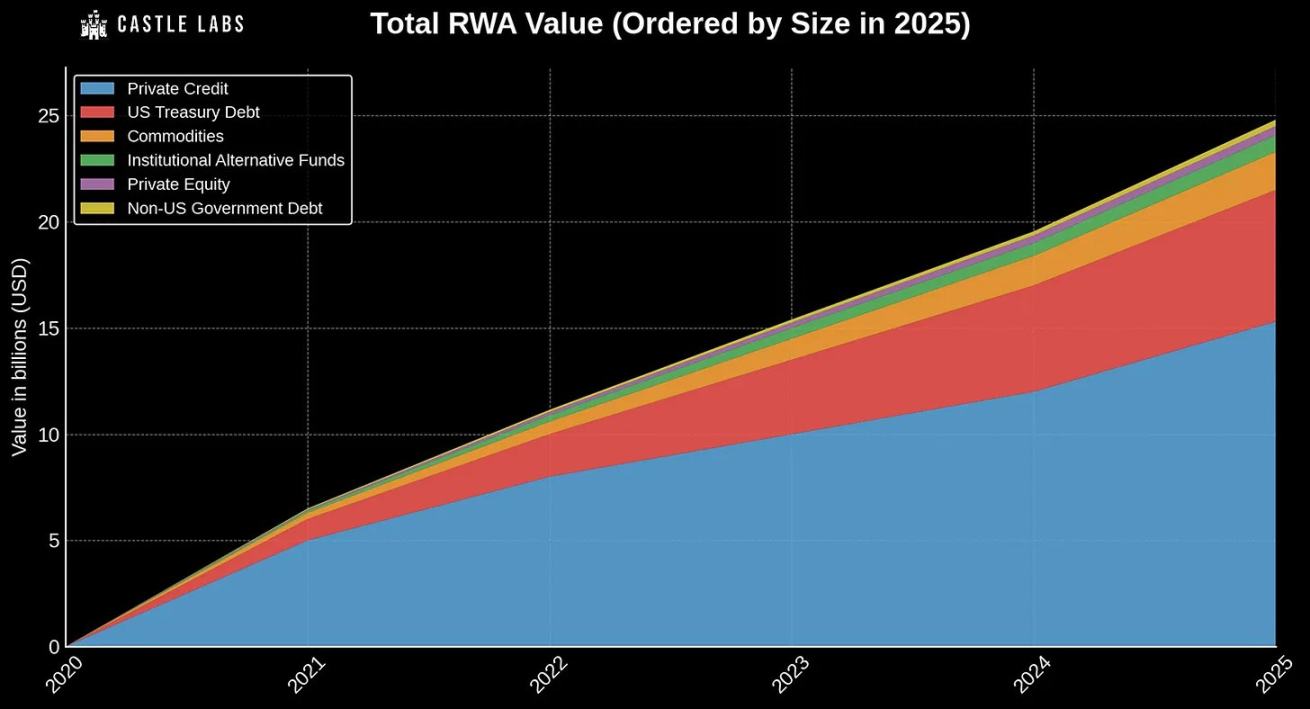
Source: rwa.xyz
The current RWA market exceeds $25 billion in value, with the following breakdown:
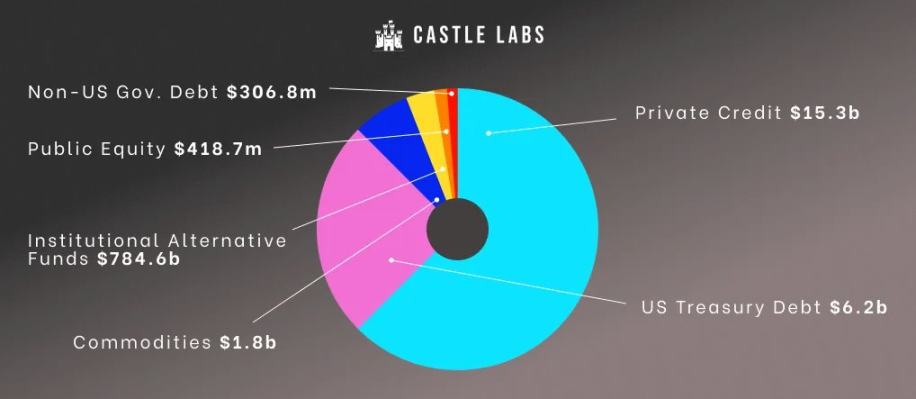
Source: rwa.xyz
- Private Credit: $15.3 billion (60%)
- U.S. Treasuries: $6.2 billion (26.9%)
- Commodities: $1.8 billion (7.2%)
- Institutional Alternative Funds: $784 million (3.26%)
- Private Equity: $418.7 million (1.71%)
- Non-U.S. Government Bonds: $306 million (about 1.2%)
Several factors have enabled on-chain RWA growth:
- Evolving digital asset regulatory frameworks
- Production-grade technical infrastructure
- Rapidly increasing institutional interest
Crypto is now being integrated into regulatory systems—for example, with Europe’s MiCA, and the recently passed GENIUS Act in the U.S.—helping legitimize such assets in broader financial contexts.
Simultaneously, networks like Bitcoin and Ethereum have been running securely for over a decade, demonstrating robust security, high activity, and decentralization.
Yet RWAs’ unique requirements mean higher assurance is required before tokenization. Layer 2 solutions have proven especially attractive to institutional investors, reducing on-chain operating costs by orders of magnitude compared to Ethereum’s mainnet.
Among L2s, Arbitrum stands out as one of the fastest-growing solutions in the RWA sector.
Why Arbitrum?
- Mature, reliable technology stack
- Credible blockchain neutrality
- One of the largest liquidity pools in crypto
Arbitrum’s solid tech stack, based on technical innovation (such as Stylus and Timeboost), makes it a serious alternative to Ethereum’s mainnet.
Its backend technology also powers cross-chain USDC bridges for projects like Hyperliquidx—extending Arbitrum’s reach beyond its core ecosystem and showcasing its trustworthy neutrality. Blockchain neutrality means the network operates with fairness, treating all users, applications, and results equally.
Credible neutrality matters because:
- Trust: Users and institutions prefer platforms that don’t change rules or play favorites.
- Security: Neutral systems are more resistant to manipulation or centralization.
- Composability: DeFi innovation thrives when developers know no protocol will get special treatment.
- Institutional Confidence: Neutrality helps protect tokenized assets from risks like censorship or biased governance.
Arbitrum also boasts the sixth-largest pool of assets in the sector—over $1.17 billion—and one of the most advanced stablecoin ecosystems.
RWAs can represent physical assets and yield-generating instruments, combining blockchain programmability and transparency. This creates new opportunities for diversified investments, stable yields, and improved capital efficiency for institutions and DAOs.
What Initiatives Have Driven Growth?
This section reviews the evolution of RWAs inside Arbitrum. The Foundation and Arbitrum DAO jointly drove early progress.
Arbitrum DAO’s RWA efforts began with the Stable Treasury Endowment Proposal (STEP), followed by the RWA Innovation Grant program, Treasury Management Proposals, and STEP 2.
STEP (April 2024)
STEP planned to allocate over $85 million (35 million ARB) through institutional issuers into tokenized U.S. Treasuries and other RWAs.
Initially a pilot, STEP carefully vetted applicants and selected several providers:
- Securitize’s BUIDL
- Ondo Finance’s USDY
- Superstate’s USTB
- Mountain Protocol’s USDM
- OpenEden’s TBill
- Backed’s bIB01
Key selection criteria:
- No investment restrictions
- Clear, unified corporate structure
- Significant assets under management, multiple ISIN exposures, experienced teams
- Use of public or decentralized tools/networks vs. proprietary ones
- Avoidance of extra decentralized governance layers
- Comprehensive documentation
To ensure diverse coverage, STEP also plans to annually allocate 1% of the DAO treasury to tokenized RWAs for five years. This provides practical experience balancing ecosystem growth with capital protection, which future program iterations may further focus on.
STEP has delivered strong results, generating $600,000 in interest for Arbitrum DAO in less than a year.
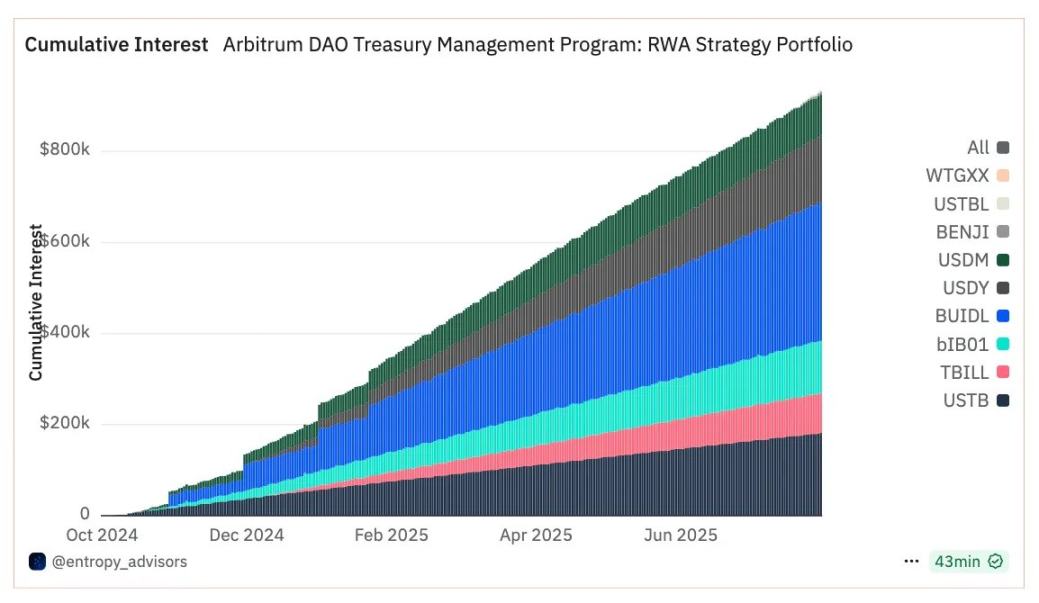
Monthly cumulative amounts:
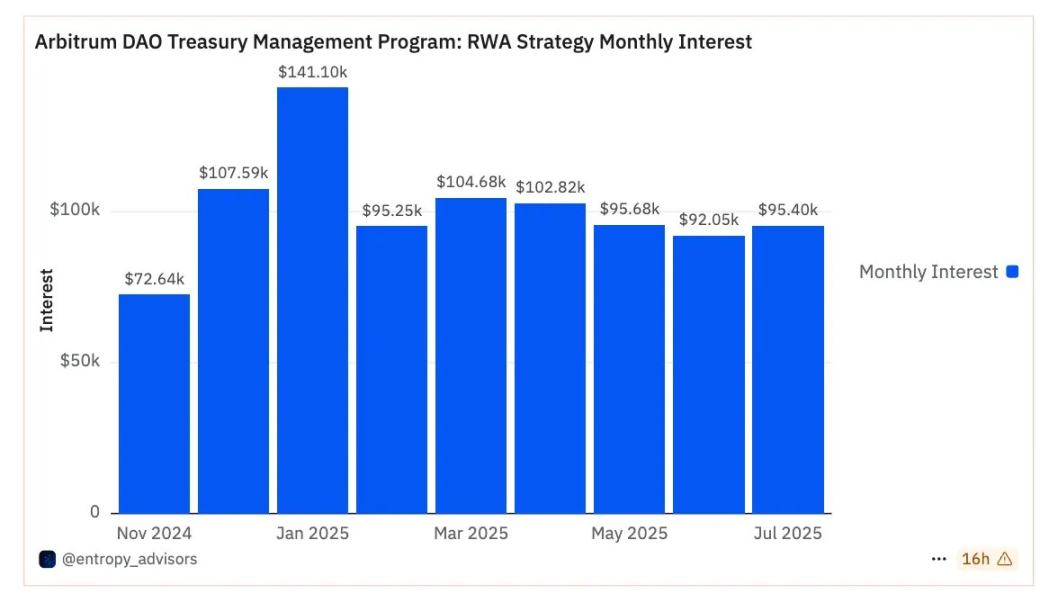
STEP is unique for its principles in working with institutional providers:
- Directly assess and select yield-generating stable assets—no intermediaries
- Request for Proposal (RFP) model allows protocol participants to submit products and undergo review
- Institutions apply directly in decentralized forums; the program aims to create sustainable DAO income
RWAIG Grants (June 2024)
The Arbitrum Foundation funded a two-month innovation grant pilot (RWAIG) running June–August 2024, with a budget of 300,000 ARB, supporting RWA integration, analysis, and research on Arbitrum.
Main goals:
- Boost RWA activity on Arbitrum, secure a competitive edge, and guarantee platform growth
- Explore mechanisms for DAO treasury investment in RWA and RWA tokenization on Arbitrum
- Integrate RWA assets and tools more broadly in major ecosystem apps (GMX, Aave, Pendle)
Eight projects received funding:
- RWA Research: Educates users
- PYOR: RWA analytics dashboard
- Mystic Finance: RWA-backed stablecoin lending market
- Jia: SME receivables tokenization
- Truflation: Real-time inflation data
- Backed Finance: Structured products tracking securities
- Infinfty: ERC-6651 RWA tokens tracking product lifecycle (procurement, performance, ownership, impact)
Treasury Management (December 2024)
At year-end 2024, a treasury management proposal expanded prior STEP work, focusing on passive yield generation from ARB tokens using on-chain strategies, rather than leaving tokens idle.
Goals:
- Manage 25 million ARB to produce on-chain returns
- Simplify ARB-to-stablecoin swaps, minimize slippage and market impact
- Convert 15 million ARB to stablecoins and deploy in low-risk yield strategies to cover DAO and provider costs
- Prioritize diversification, risk-adjusted returns, and capital safety
This strategy splits into two tracks:
- Treasury: 10 million ARB in ARB-only strategies; 15 million ARB converted to stablecoins, serving as the DAO’s “checking account”
- Growth: Deploy 7,500 ETH in DeFi sectors
STEP 2 (January 2025)
Following STEP’s success, STEP 2 was approved—adding 35 million ARB ($15.7 million).
After reviewing 50+ applications, STEP’s committee allocated assets as follows:
- WisdomTree WTGXX: 30%
- Spiko USTBL: 35%
- Franklin Templeton FOBXX (BENJI): 35%
DAO endorsement underscores the program’s importance: STEP 2 passed with nearly 89% support, 11% abstention, and only 0.01% opposition.
These initiatives have driven Arbitrum’s RWA TVL from near zero to over $70 million in less than a year.
What’s the current landscape?
What is the RWA ecosystem on Arbitrum?
The next section uses on-chain data to analyze RWA assets, providers, and growth on Arbitrum.
Growth of RWA on Arbitrum
Thanks to its low-cost, high-throughput design and credible neutrality, Arbitrum is quickly building an ecosystem of issuers, infrastructure providers, and incentive programs fueling large-scale RWA tokenization.
While Arbitrum initially focused on DeFi infrastructure, DEXs, lending protocols, and yield aggregators, early experiments with tokenized U.S. Treasuries on Ethereum in 2022 broadened interest in bringing off-chain assets on-chain.
Currently, Arbitrum’s RWA market cap is approaching $350 million, with more than 129 distinct tokenized assets. While impressive, this is only 1.39% of total RWA market cap—suggesting strong upside ahead.
Forecasts for on-chain RWA growth include:
- $16 trillion by 2030 (10% of global GDP)
- $30 trillion by 2034
This could mean 40x growth in the next five years under the first scenario.
As one of the most mature RWA networks, Arbitrum is well positioned for competitive advantage.
Growth Timeline of RWA on Arbitrum
In 2024 alone, Arbitrum’s RWA TVL increased from nearly zero to nearly $85 million by year-end.
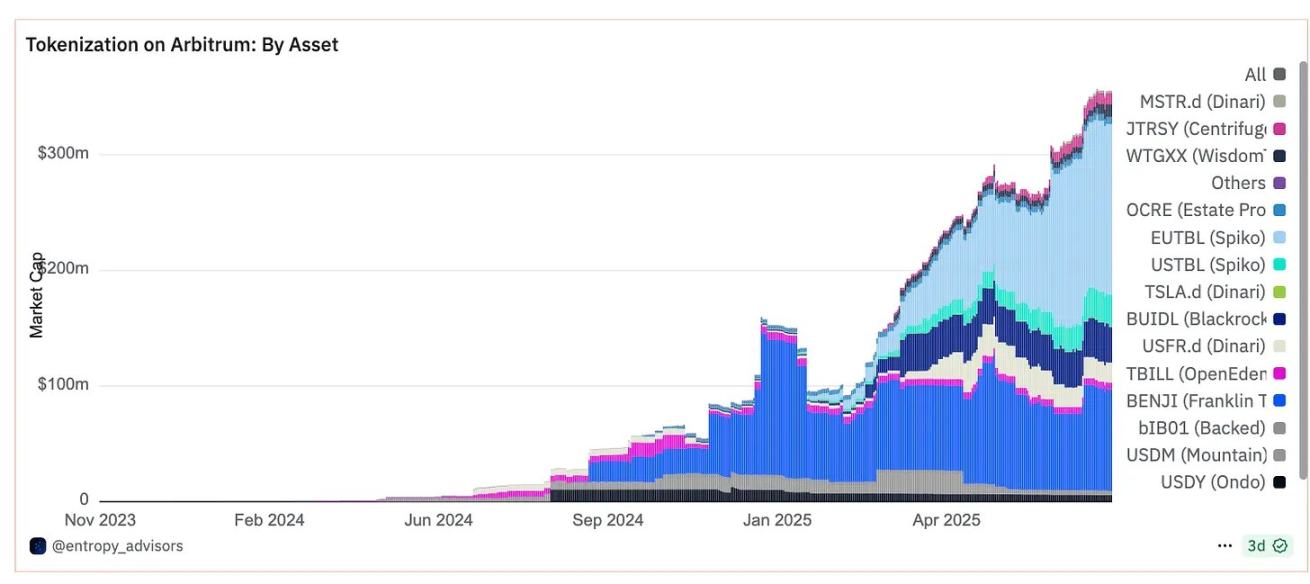
This growth falls into three major phases, correlating with the initiatives above:
- Early Growth (Q1 2024): RWA TVL surged from nothing to over $5 million, signaling initial traction.
- Major Expansion (Q2 2024): TVL jumped from $20 million to $70 million, in parallel with STEP 1 capital deployment.
- Ongoing Expansion: As DAO treasury allocations rise (STEP 2) and new issuers (Spiko, WisdomTree, BlackRock) enter, growth is expected to continue through 2025.
This evolution is also reflected in supported asset types. In 2024, U.S. Treasuries dominated, with new asset classes added over time.
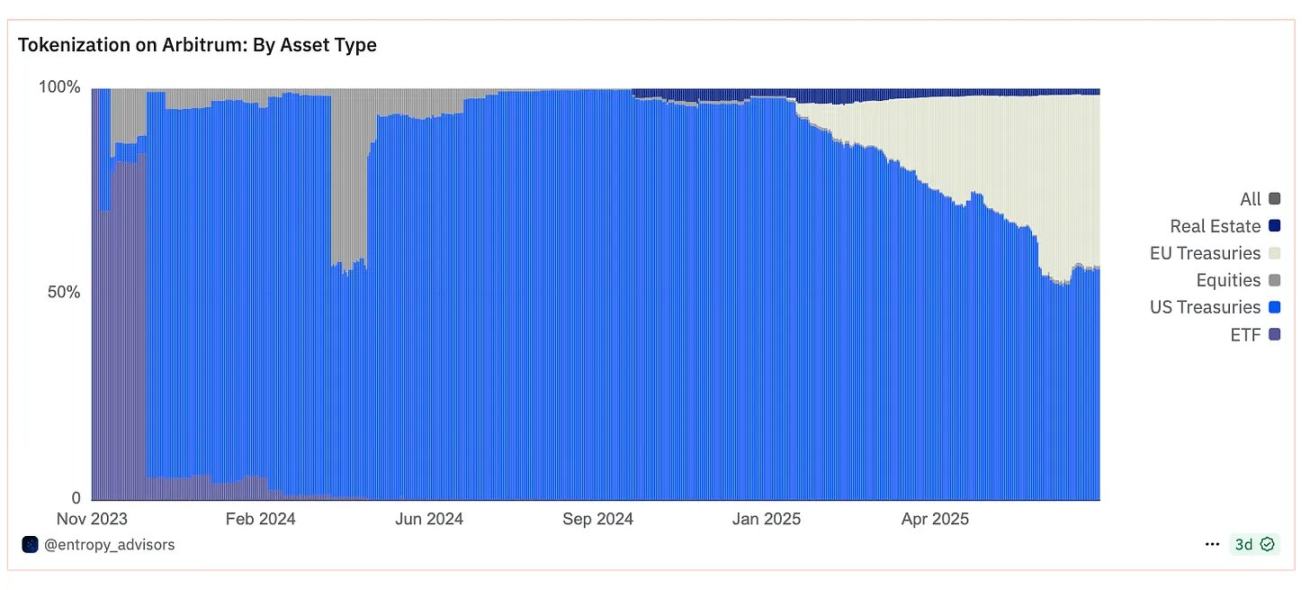
U.S. Treasuries still lead ($197 million), but EU sovereign bonds ($150 million) are closing in. Alternative assets like real estate, stocks, and ETFs are also being adopted.
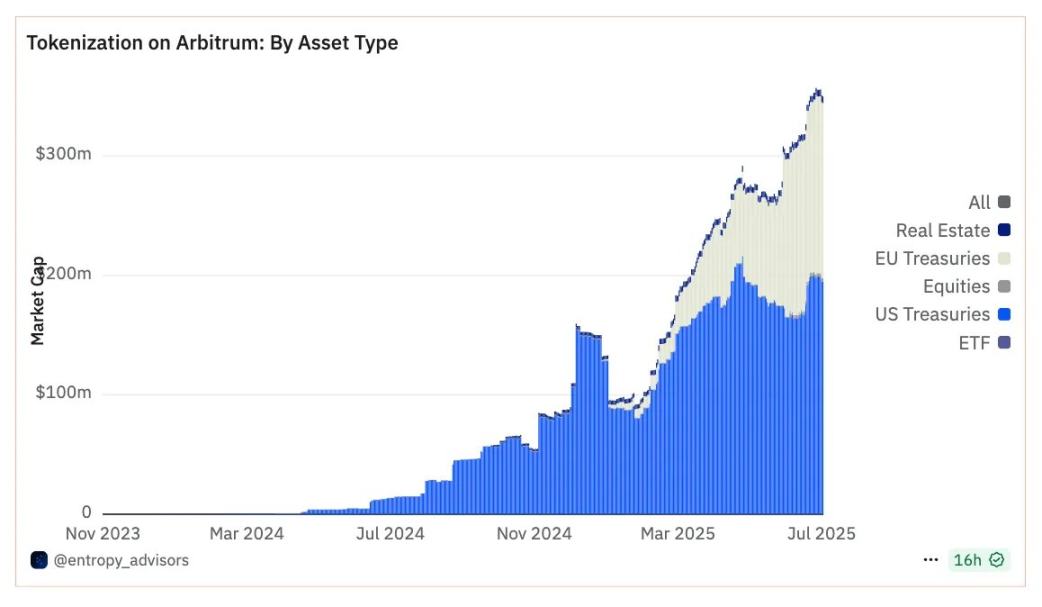
RWA Assets & Providers
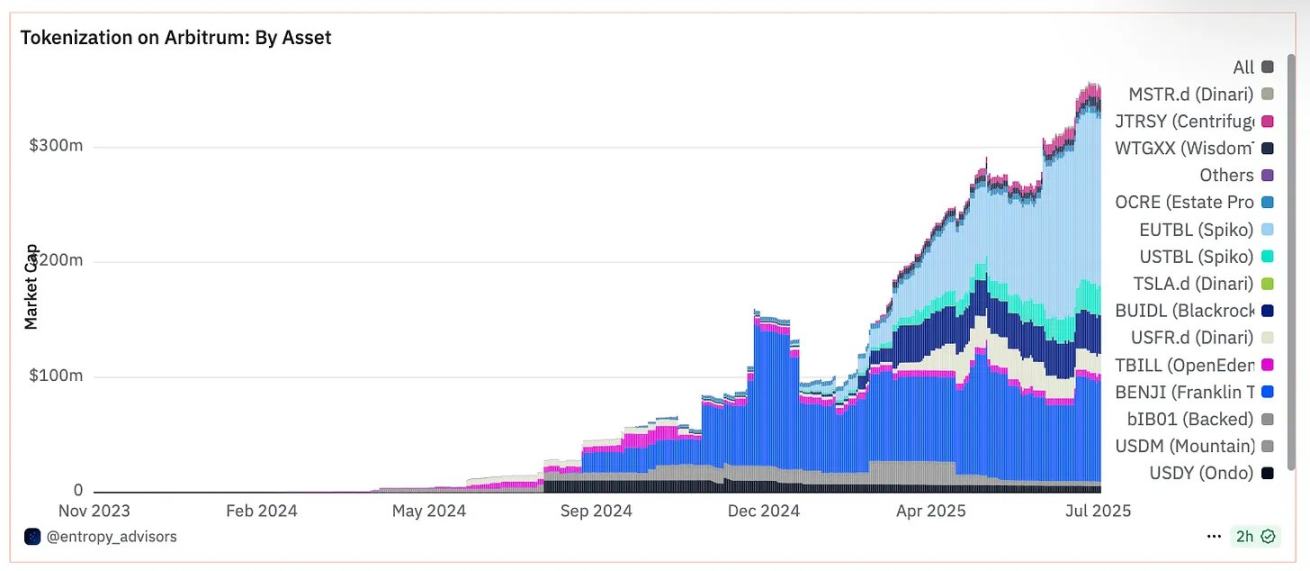
This section examines the asset categories and profiles the top 10 RWA products by value, organized by issuer.
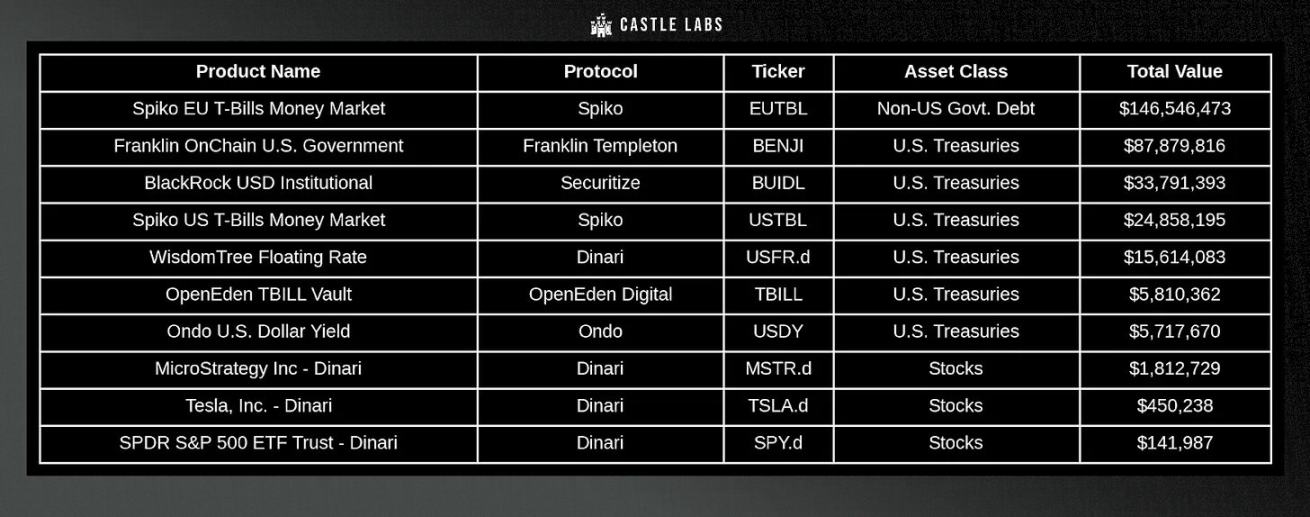
Spiko
Spiko operates an on-chain securities token issuance and distribution platform.
Licensed by France’s AMF, it offers two money market funds:
- Spiko Euro (EUTBL)
- Spiko US Dollar (USTBL)
Both are backed by short-term sovereign bonds, with yields closely matching central bank risk-free rates. They are among the most widely used RWA products: EUTBL tops the chart at $146 million, while USTBL ranks fourth with $24.8 million—demonstrating the popularity of short-term sovereign debt on chain.
Franklin Templeton
Franklin Templeton is a NYSE-listed investment manager (BEN).
To bring tokenized mutual funds on-chain, they launched the BENJI mobile app and a proprietary recordkeeping system for tokens and crypto assets.
Each BENJI token represents a share of Franklin’s OnChain U.S. Government Money Market Fund (FOBXX). BENJI is currently the second-largest RWA product on Arbitrum, valued at over $87 million.
Securitize
Securitize offers institutional access to tokenized securities.
On Arbitrum, it provides BlackRock’s USD institutional digital liquidity fund (BUIDL).
This tokenized short-term Treasury product focuses on on-chain dollar yield, currently worth more than $33 million.
Dinari
Dinari enables tokenization of stocks, ETFs, and indexes—called “dShares”—with 1:1 asset backing.
On Arbitrum, Dinari has launched:
- WisdomTree US Floating Rate Treasury Fund (USFR.d): Over $15 million in U.S. floating-rate sovereign bonds.
- Tokenized MicroStrategy stock (MSTR.d): $1.8 million value.
- Tokenized Tesla stock (TSLA.d): $450,000 value.
- Tokenized S&P 500 Index ETF Trust (SPY.d): $141,000 value.
These options showcase the potential for stocks and indexes, though their share of Arbitrum’s RWA market remains limited.
OpenEden
OpenEden provides access to tokenized U.S. securities. Licensed by Bermuda’s financial authority, it holds a digital asset license and a Moody’s “investment grade” rating.
OpenEden leads tokenized U.S. Treasury issuance for Europe and Asia, offering a TBILL pool for short-term U.S. Treasuries.
The pool now has more than $5.8 million in deposits.
Ondo
Ondo enables access to institutional-grade financial products.
On Arbitrum, its USDY product has gained significant traction, with $5.7 million in value.
USDY is a yield-generating stablecoin backed by U.S. Treasuries, with an annual yield near 4.29%.
Despite Arbitrum’s diverse RWA offering, the ecosystem remains in its early stages.
Its future growth will hinge on:
- Chain-level expansion to serve broader needs
- Strategic focus on RWAs as a core Arbitrum strength
- Collaboration between Arbitrum Alliance Entities (AAE)
- Institutional business development momentum
Future Outlook
STEP 1’s initial providers have been joined by new names in STEP 2, expanding asset diversity and product options on Arbitrum.
Given the current pace of RWA TVL growth, we expect:
- Formation of a billion-dollar RWA ecosystem
- Inclusion of more assets (private credit, real estate, yield-bearing stablecoins, etc.)
- Deeper interoperability between networks for these assets
Arbitrum still has vast growth potential if it wants to solidify its position in this sector. In total network ranking, Arbitrum is seventh for RWA asset value; at $350 million, it represents only 1.39% of on-chain RWAs—a tiny fraction.

To keep up with other networks, Arbitrum should expand into private credit issuance, bonds, precious metals—and equities.
With Entropy’s involvement in Arbitrum treasury management and RWAs, we interviewed Matt for his views on Arbitrum’s RWA future. Here’s his perspective:
“Today, most RWA issuers are focused on lowering operating costs for issuance and transfer, but there’s a long way to go for validating this at scale. The next major breakthrough for RWAs on Arbitrum will be composability.
This isn’t just about adding asset categories or issuers—that’s only the first step. The real breakthrough is connecting these assets with core on-chain modules built over the past decade: exchanges, lending protocols, index tools, pool optimizers, and future innovation. The ultimate goal is open, permissionless transferability so RWAs are as composable as native crypto. We’re not there yet—given current regulations, that’s a big vision—but it’s our North Star.
The fact that major institutions like Franklin and WisdomTree now issue their own tokens is a positive sign. True institutional engagement is happening, and I hope this trend continues. If we see user RWA activity (trading and lending) take place on-chain—even abstracted through permissioned Arbitrum channels—it could unlock a new era.”
We align fully with Matt, especially on composability and broad access. The on-chain utility of these assets is just emerging, and we anticipate that T-bills, bonds, stocks, and commodities will soon be tokenized and integrated with core DeFi building blocks.
Methodologically, note that this RWA report excludes stablecoins, as our focus is on assets currently usable on Arbitrum.
Finally, based on this analysis, a review of risk and key considerations is essential.
Risks & Forward-Looking Considerations
- Token–ecosystem disconnect: Growth in RWAs does not directly drive ARB token value.
- Concentration risk: Short-term Treasuries make up most of RWA TVL, highlighting the need for more diversified exposure—private credit, corporate bonds, real estate, and more.
- Regulatory risk: Despite progress, compliance for tokenized securities is still evolving, and institutional issuers need clarity and cross-border alignment.
Expansion of asset issuers and growth in RWA categories like private credit and real estate could drive Arbitrum TVL close to $1 billion by year-end.
As treasury management and STEP 2 progress, expect more insights and learnings to inform future decisions and initiatives.
Conclusion
Arbitrum’s RWA TVL has surged from almost nothing to $350 million in just over a year.
The STEP plan and DAO-led initiatives were pivotal, bringing a diverse set of institutional-grade products to Arbitrum: short-term Treasuries, money market funds, tokenized stocks, and more.
Major institutions like Franklin Templeton and WisdomTree have further cemented Arbitrum’s status as a reliable, neutral, and cost-effective network for institutional DeFi.
But this is just the start.
Beyond risk and challenges, Arbitrum faces multiple strategic opportunities in the next few months.
These include expanding into RWA categories such as private credit, real estate, and commodities, but most importantly, advancing composability so new assets integrate deeply with Arbitrum’s core DeFi modules (DEXs, lending, liquidity pools, etc.).
With STEP 2 and treasury management initiatives providing practical experience, coordination among DAOs, alliances, and institutions will be key to long-term leadership in the RWA space.
Disclaimer:
- This article is reposted from Foresight News. Original title: "350 Million Is Just the Beginning: What Wealth Secrets Are Hidden in Arbitrum’s RWA Ecosystem?" Copyright belongs to Castle Labs. For concerns about reposting, please contact the Gate Learn Team ) and the team will handle it based on relevant procedures.
- Disclaimer: The views and opinions expressed are those of the author and do not represent investment advice.
- Other language versions are translated by the Gate Learn Team and may not be reproduced, distributed, or plagiarized without reference to Gate.
Related Articles

Reshaping Web3 Community Reward Models with RWA Yields

ONDO, a Project Favored by BlackRock

Real World Assets - All assets will move on-chain

What Are Crypto Narratives? Top Narratives for 2025 (UPDATED)

Gate Research: Understanding the Core Logic and Hot Projects of RWA in One Article
